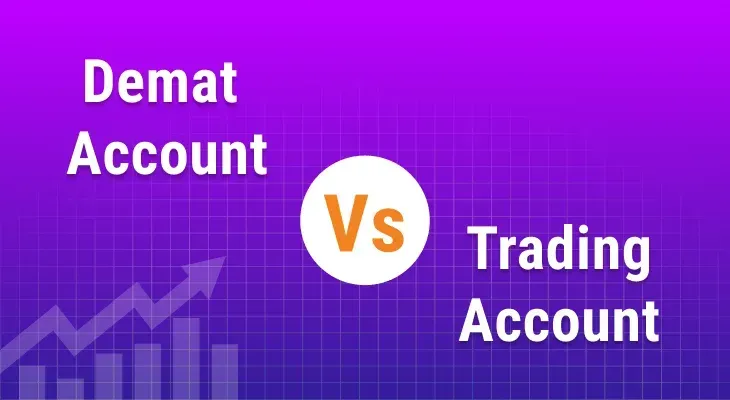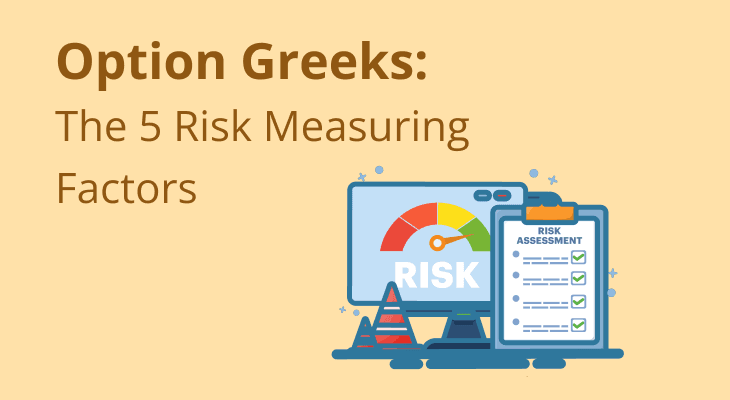
Table of content
- What is a Demat Account?
- What is a Trading Account?
- Difference between Demat Account and Trading Account
- Demat vs Trading account: Know the functionality
- Demat and Trading Account Opening Process
- Fees and Charges for Opening a Demat and Trading Account
- Can You Open a Demat Account Without Having a Trading Account or Vice Versa?
- Conclusion
Difference between Demat and Trading Account
If you are planning to trade in the stock market, you may have come across these terms demat account and trading account. While many new investors use both these terms interchangeably, it is important to note that they are quite different from each other. Each type of account serves a specific purpose, and you need both to invest and trade in the share market. In this blog, you will understand the difference between the two and how they help you in your trading & investment journey in the stock markets.
What is a Demat Account?
A demat (or dematerialised) account holds your shares and securities electronically. It helps you track your investments, including Stocks, Margin trading facility, Mutual funds, Exchange-Traded funds, Bonds etc., in a single place.
Just like a bank account, every demat account has a unique account number. The demat account number serves as the identifier for your investment with a specific depository participant. As an investor, you need to make a note of your demat account number and quote it in all your communications with the broker.
What is a Trading Account?
A trading account enables you to buy and sell shares of various companies listed on the stock market. The shares purchased using a trading account are stored in the demat account electronically. And when you wish to sell your shares, you can use your trading account to sell them. With m.Stock, you can open a trading account and access features like advanced technical charts, live news and market updates, pre-designed index baskets, flexible watchlists, etc.
Difference between Demat Account and Trading Account
Demat Account | Trading Account |
|---|---|
| It is used to store stocks and securities in a digital format. | It is used to buy or sell stocks and securities in the stock market. |
| A demat account can be opened without buying any stocks or securities. | It is necessary to transfer the funds from the bank account to buy securities. |
| You can freeze your demat account anytime and for as long as you want to ensure there are no unpredictable debits and credits in your demat account when you are not using it. | A trading account can be considered as a bridge between your bank and demat accounts. |
| When you have a demat account, you can convert your physical shares into electronic format by submitting a dematerialisation request. | A trading account allows you to trade through various exchanges, and it can be accessed on your mobile, laptop, tablet, etc. |
| A demat account gives you the benefit of getting dividends, returns or interest automatically in your account. | With a trading account, you can access all the stock exchanges in India including BSE, NSE, commodity exchanges and derivatives exchanges. |
Demat vs Trading account: Know the functionality
The major difference between the two accounts is the functions they perform. While a trading account is used to buy and sell securities, a demat account allows an investor to hold their securities in an electronic form.
For example, to buy 500 shares of ABC Ltd, you can use your trading account to carry out the transaction. Once you purchase the shares, they are credited to your demat account, and it remains in the demat account till the time they are sold. Let's say that out of the 500 shares, you decide to sell 100 shares, you can use the trading account for selling, and your demat account will be debited by 100 shares, and 400 shares will remain in your demat account.
Demat and Trading Account Opening Process
Opening a Demat and trading account is the first step towards participating in the stock market. These accounts are essential for buying and selling securities such as shares, bonds, and mutual funds.
Choose a Broker: To open a Demat and trading account, the first step is to choose a registered stockbroker. You can opt for traditional brokers or a reputed online discount broker like m.Stock. Ensure that the broker offers both Demat and trading services.
Complete the KYC Process: The next step is to complete the Know Your Customer (KYC) process. This involves submitting documents such as identity proof (Aadhar card, passport, voter ID), address proof (electricity bill, bank statement), and passport-sized photographs. These documents are required to verify your identity and address.
Fill out the Application Form: Once your KYC documents are verified, fill out the application form provided by the broker. This form captures your personal details like name, contact number, bank account information, and nominee details.
Sign the Agreement: The broker will provide you with an agreement that outlines the terms and conditions of using their services. This agreement must be signed before the account is activated.
Online or Offline: Depending on your broker, you may either complete the process online through their website or in person at the broker’s office.
Account Activation: Once the verification is complete, your Demat and trading accounts will be activated. The process typically takes 2-3 working days. After activation, you will receive your Demat account number (DP ID) and trading account details to start trading.
Fees and Charges for Opening a Demat and Trading Account
Although opening a Demat and trading account online is quite simple, understanding the fees and charges associated with these accounts is important for effective financial planning.
Account Opening Fee: Many brokers charge an initial fee for opening a Demat and trading account. This fee may apply depending on the broker and the type of account you choose.
Annual Maintenance Charges (AMC): This is one of the recurring fees associated with a Demat account. It is charged yearly for maintaining your Demat account and varies from broker to broker. It’s essential to compare AMCs before selecting a broker.
Brokerage Charges: Brokerage fees are charged when you buy or sell securities. These charges are typically calculated as a percentage of the trade value or can be a flat fee per trade. Discount brokers often have lower brokerage fees compared to traditional brokers. Brokerage charges can vary between 0.01% to 0.3% for each transaction.
Transaction Fees: Both Demat and trading accounts are subject to transaction charges, including securities transaction tax (STT), exchange transaction charges, and service tax. These fees can vary depending on the type of transaction and the exchange.
Pledge and Dematerialisation Charges: If you wish to pledge your shares as collateral or dematerialise physical certificates into electronic form, there may be additional charges. These fees are typically nominal but should be kept in mind.
GST: Goods and Services Tax (GST) is levied on certain charges like brokerage fees, transaction charges, and other services provided by the broker. The GST rate is typically 18% on most charges.
Before opening a Demat account and trading account, it’s crucial to thoroughly understand all the fees and charges involved. Comparing brokers based on their fee structure can help you choose the most cost-effective option for your needs. Opting for a broker like m.Stock, with low to zero charges across a variety of categories, can help you save big in the long run.
Can You Open a Demat Account Without Having a Trading Account or Vice Versa?
A common question among new investors is whether you can open a Demat account without having a trading account, or the other way around. The simple answer is yes, but it’s important to understand the difference between a Demat account and a trading account before making any decisions.
Opening a Demat Account Without a Trading Account: Yes, you can open a Demat account without a trading account. A Demat account is primarily used for holding securities like stocks, bonds, or mutual funds in electronic form. If you wish to invest in securities and hold them for the long term, but do not wish to trade frequently, you may opt for a Demat account alone. However, if you want to trade, you’ll need a trading account linked to your Demat account.
Opening a Trading Account Without a Demat Account: On the other hand, it is not possible to open a trading account without a Demat account. The trading account enables you to place buy or sell orders for securities, but the actual securities are held in the Demat account. Therefore, both accounts work in tandem. A trading account without a Demat account would mean there’s nowhere to store your purchased securities.
Why Do You Need Both Accounts?: If you wish to actively trade in the stock market, having both a Demat account and trading account is essential. The Demat account holds your securities, while the trading account enables you to buy and sell them on stock exchanges. Both accounts are needed to complete the entire trading process.
In summary, while you can open a Demat account without a trading account, the reverse is not possible. To start trading and managing your investments, you need both accounts working together. Always understand the importance of Demat accounts and trading accounts when planning your investment strategy.
Conclusion
Demat account and trading account work in tandem. You must open both accounts if you are looking to trade in the financial markets. m.Stock is a one-stop solution to invest in various securities, including equities, mutual funds, bonds and currencies.
FAQ
Which is the best demat and trading account?
The ideal demat and target account offers a seamless and user-friendly interface with analytical tools at low or zero brokerage. m.Stock offers all these features and more and lets you buy shares, futures and options, IPOs, currencies and mutual funds.
What are the charges for opening an m.Stock demat and trading account?
Different brokers have different fee structures for demat and trading accounts. On m.Stock, you can open a free demat. By opening free demat account you can avail the benefit of zero brokerage on Equity Delivery, IPO, ETFs and Mutual Fund orders.
Is it possible to have a trading account without a demat account?
Theoretically, it is possible to have a trading account without a demat account, but stockbroking firms generally open a demat account for customers with a trading account at no additional cost.
Is it possible to have a trading account without a demat account?
No, you cannot have a trading account without a Demat account. While a trading account allows you to execute buy and sell orders, a Demat account is required to hold the securities in electronic form. Both accounts work together to complete the transaction process.
Who Is Eligible to Open a Demat and Trading Account?
Any Indian citizen can open a Demat and trading account. Non-resident Indians (NRIs) can also open these accounts subject to certain guidelines. However, currently m.Stock does not allow minors or NRIs to open a Demat & trading account. You must complete the eKYC process and submit identity and address proof to be eligible to open both accounts.
Do You Need Both a Demat and Trading Account to Invest?
Yes, to invest in the stock market, you need both a Demat account and a trading account. The trading account facilitates buying and selling, while the Demat account holds the securities you purchase. Both accounts are essential to complete the investment process smoothly.


